University Literature Review: Supply Chain Integration and Quality
VerifiedAdded on 2020/03/07
|11
|2851
|156
Literature Review
AI Summary
This literature review examines the relationships between supply chain integration and product quality, focusing on the impact of customer, supplier, and internal integration. The study explores how these integrations influence design and conformance quality within the manufacturing sector. It discusses key concepts such as customer integration (acquiring information to meet customer preferences), supplier integration (sharing data for effective decision-making), and internal integration (coordination across departments). The review analyzes six hypotheses related to the effects of supply chain integration on design and conformance quality, based on the work of Lotfi et al. (2013) and others. The findings emphasize the importance of information sharing and collaborative activities among suppliers, customers, and manufacturers to achieve desired product quality. The review also highlights the implications of these relationships and suggests areas for further research, particularly the need for more comprehensive analysis of the various dimensions of supply chain integration and their effect on product quality.
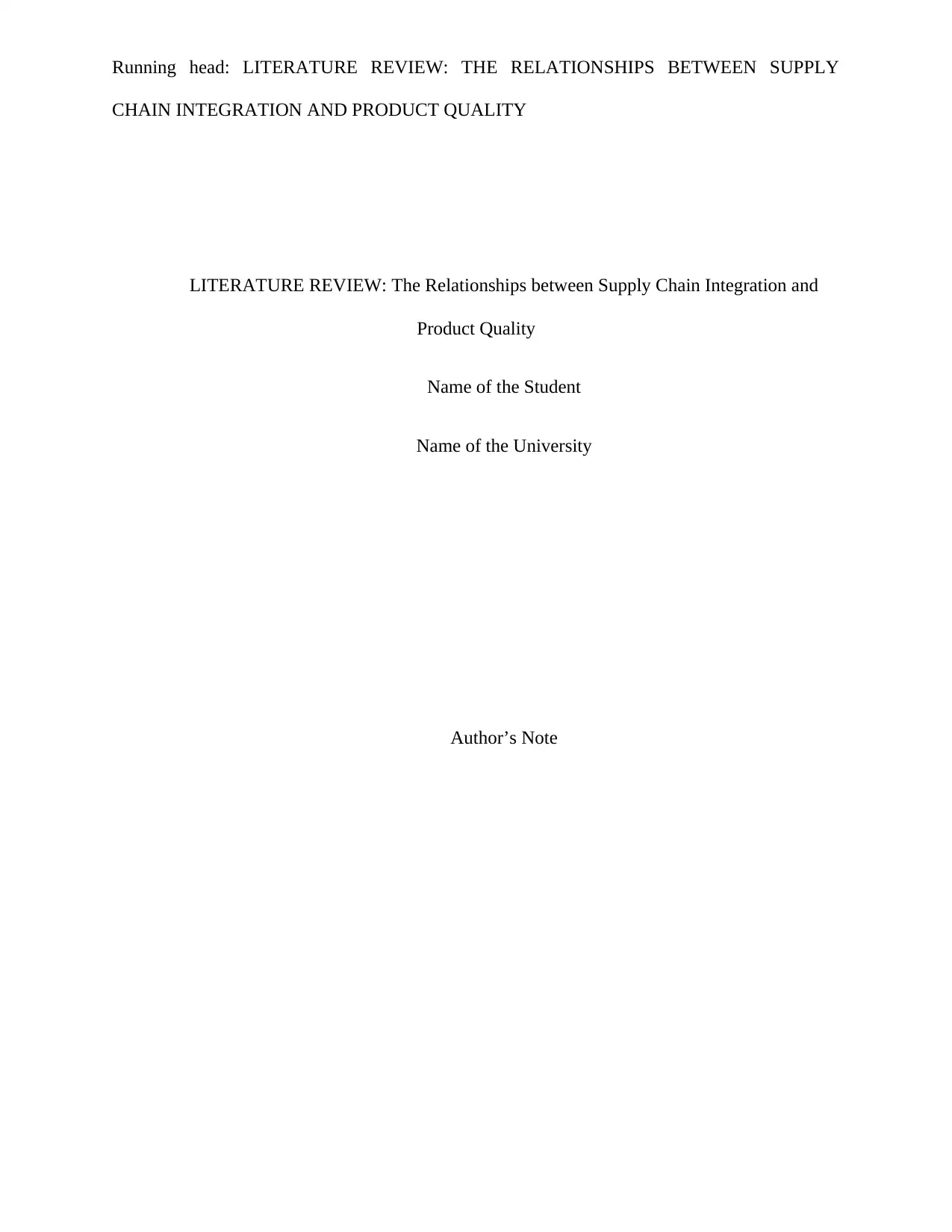
Running head: LITERATURE REVIEW: THE RELATIONSHIPS BETWEEN SUPPLY
CHAIN INTEGRATION AND PRODUCT QUALITY
LITERATURE REVIEW: The Relationships between Supply Chain Integration and
Product Quality
Name of the Student
Name of the University
Author’s Note
CHAIN INTEGRATION AND PRODUCT QUALITY
LITERATURE REVIEW: The Relationships between Supply Chain Integration and
Product Quality
Name of the Student
Name of the University
Author’s Note
Paraphrase This Document
Need a fresh take? Get an instant paraphrase of this document with our AI Paraphraser
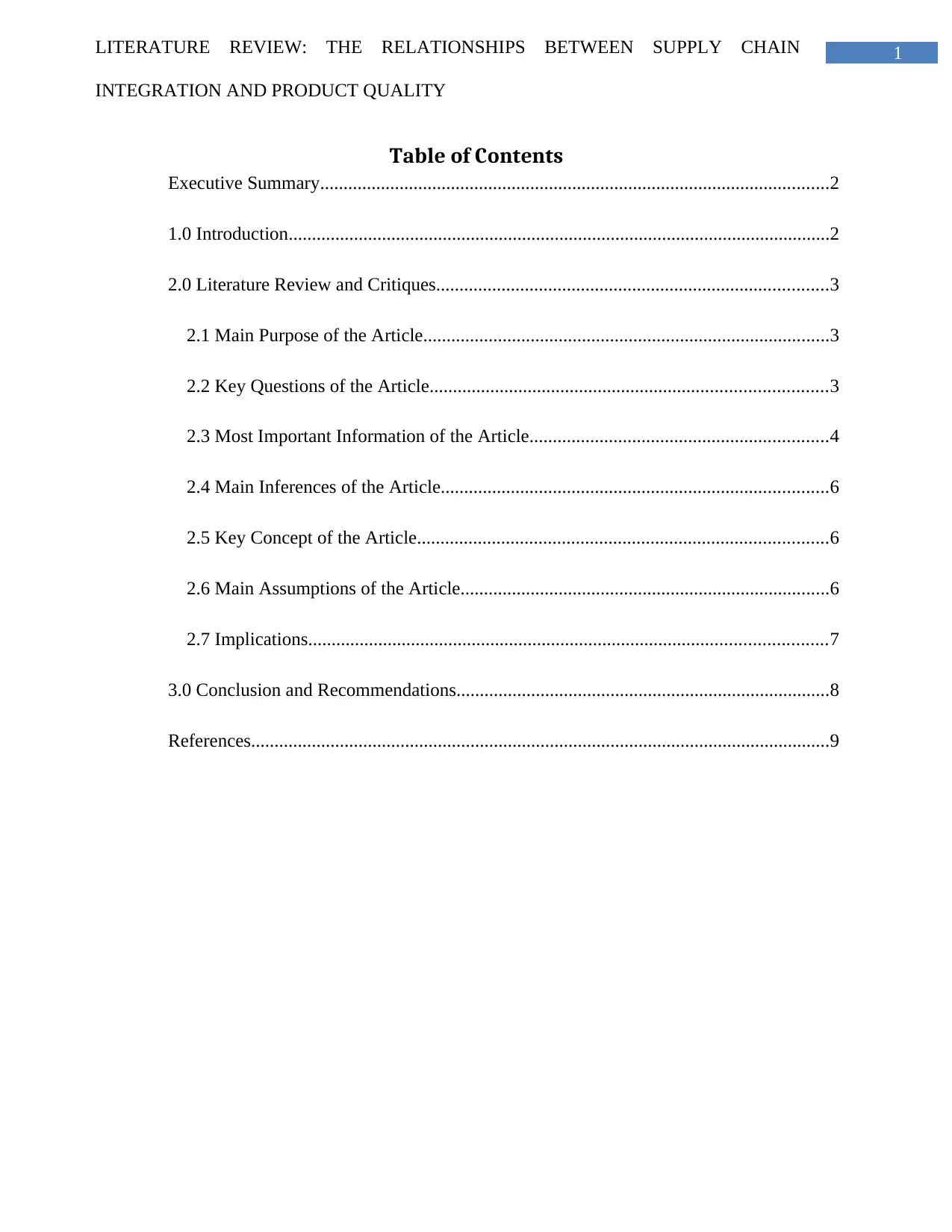
1LITERATURE REVIEW: THE RELATIONSHIPS BETWEEN SUPPLY CHAIN
INTEGRATION AND PRODUCT QUALITY
Table of Contents
Executive Summary.............................................................................................................2
1.0 Introduction....................................................................................................................2
2.0 Literature Review and Critiques....................................................................................3
2.1 Main Purpose of the Article.......................................................................................3
2.2 Key Questions of the Article.....................................................................................3
2.3 Most Important Information of the Article................................................................4
2.4 Main Inferences of the Article...................................................................................6
2.5 Key Concept of the Article........................................................................................6
2.6 Main Assumptions of the Article...............................................................................6
2.7 Implications...............................................................................................................7
3.0 Conclusion and Recommendations................................................................................8
References............................................................................................................................9
INTEGRATION AND PRODUCT QUALITY
Table of Contents
Executive Summary.............................................................................................................2
1.0 Introduction....................................................................................................................2
2.0 Literature Review and Critiques....................................................................................3
2.1 Main Purpose of the Article.......................................................................................3
2.2 Key Questions of the Article.....................................................................................3
2.3 Most Important Information of the Article................................................................4
2.4 Main Inferences of the Article...................................................................................6
2.5 Key Concept of the Article........................................................................................6
2.6 Main Assumptions of the Article...............................................................................6
2.7 Implications...............................................................................................................7
3.0 Conclusion and Recommendations................................................................................8
References............................................................................................................................9
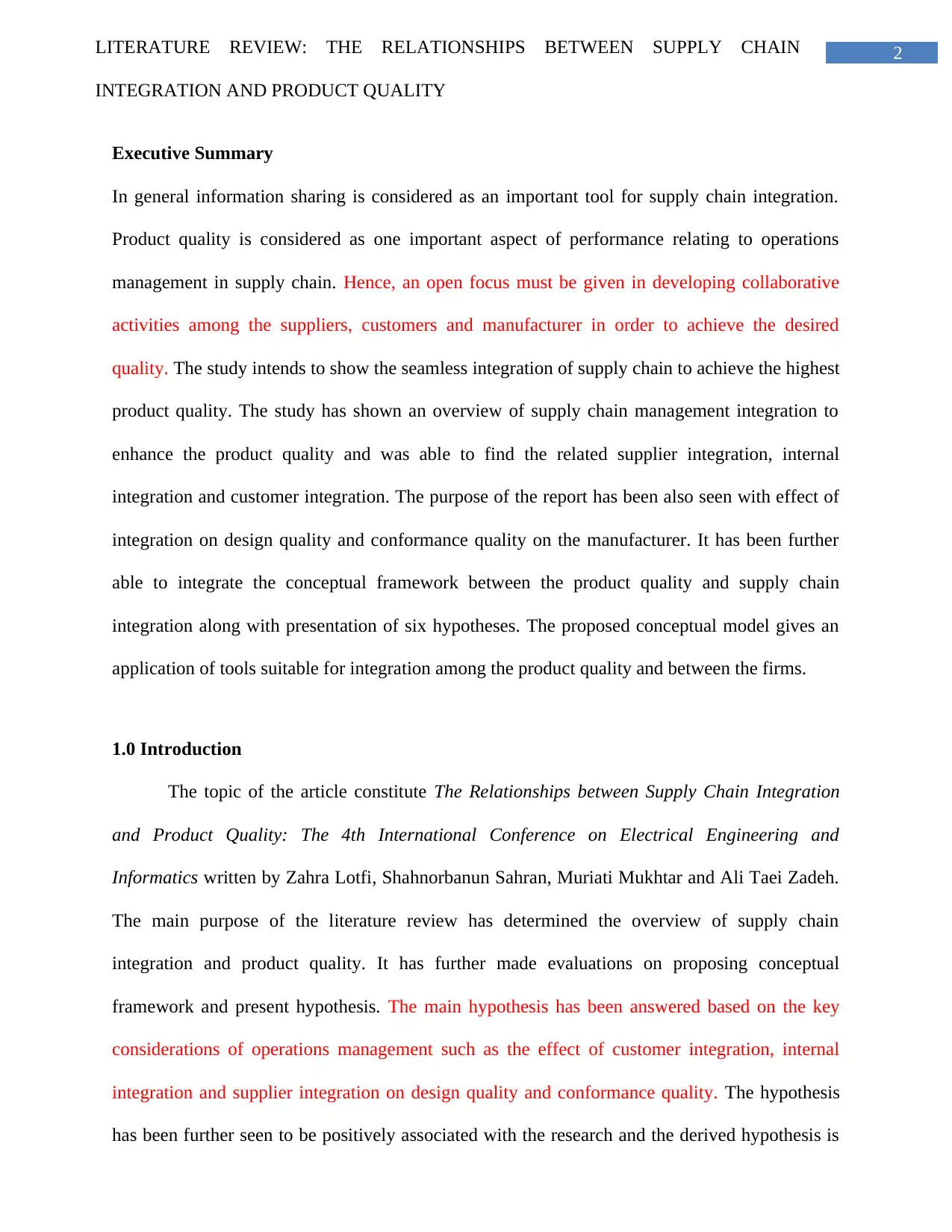
2LITERATURE REVIEW: THE RELATIONSHIPS BETWEEN SUPPLY CHAIN
INTEGRATION AND PRODUCT QUALITY
Executive Summary
In general information sharing is considered as an important tool for supply chain integration.
Product quality is considered as one important aspect of performance relating to operations
management in supply chain. Hence, an open focus must be given in developing collaborative
activities among the suppliers, customers and manufacturer in order to achieve the desired
quality. The study intends to show the seamless integration of supply chain to achieve the highest
product quality. The study has shown an overview of supply chain management integration to
enhance the product quality and was able to find the related supplier integration, internal
integration and customer integration. The purpose of the report has been also seen with effect of
integration on design quality and conformance quality on the manufacturer. It has been further
able to integrate the conceptual framework between the product quality and supply chain
integration along with presentation of six hypotheses. The proposed conceptual model gives an
application of tools suitable for integration among the product quality and between the firms.
1.0 Introduction
The topic of the article constitute The Relationships between Supply Chain Integration
and Product Quality: The 4th International Conference on Electrical Engineering and
Informatics written by Zahra Lotfi, Shahnorbanun Sahran, Muriati Mukhtar and Ali Taei Zadeh.
The main purpose of the literature review has determined the overview of supply chain
integration and product quality. It has further made evaluations on proposing conceptual
framework and present hypothesis. The main hypothesis has been answered based on the key
considerations of operations management such as the effect of customer integration, internal
integration and supplier integration on design quality and conformance quality. The hypothesis
has been further seen to be positively associated with the research and the derived hypothesis is
INTEGRATION AND PRODUCT QUALITY
Executive Summary
In general information sharing is considered as an important tool for supply chain integration.
Product quality is considered as one important aspect of performance relating to operations
management in supply chain. Hence, an open focus must be given in developing collaborative
activities among the suppliers, customers and manufacturer in order to achieve the desired
quality. The study intends to show the seamless integration of supply chain to achieve the highest
product quality. The study has shown an overview of supply chain management integration to
enhance the product quality and was able to find the related supplier integration, internal
integration and customer integration. The purpose of the report has been also seen with effect of
integration on design quality and conformance quality on the manufacturer. It has been further
able to integrate the conceptual framework between the product quality and supply chain
integration along with presentation of six hypotheses. The proposed conceptual model gives an
application of tools suitable for integration among the product quality and between the firms.
1.0 Introduction
The topic of the article constitute The Relationships between Supply Chain Integration
and Product Quality: The 4th International Conference on Electrical Engineering and
Informatics written by Zahra Lotfi, Shahnorbanun Sahran, Muriati Mukhtar and Ali Taei Zadeh.
The main purpose of the literature review has determined the overview of supply chain
integration and product quality. It has further made evaluations on proposing conceptual
framework and present hypothesis. The main hypothesis has been answered based on the key
considerations of operations management such as the effect of customer integration, internal
integration and supplier integration on design quality and conformance quality. The hypothesis
has been further seen to be positively associated with the research and the derived hypothesis is
⊘ This is a preview!⊘
Do you want full access?
Subscribe today to unlock all pages.

Trusted by 1+ million students worldwide
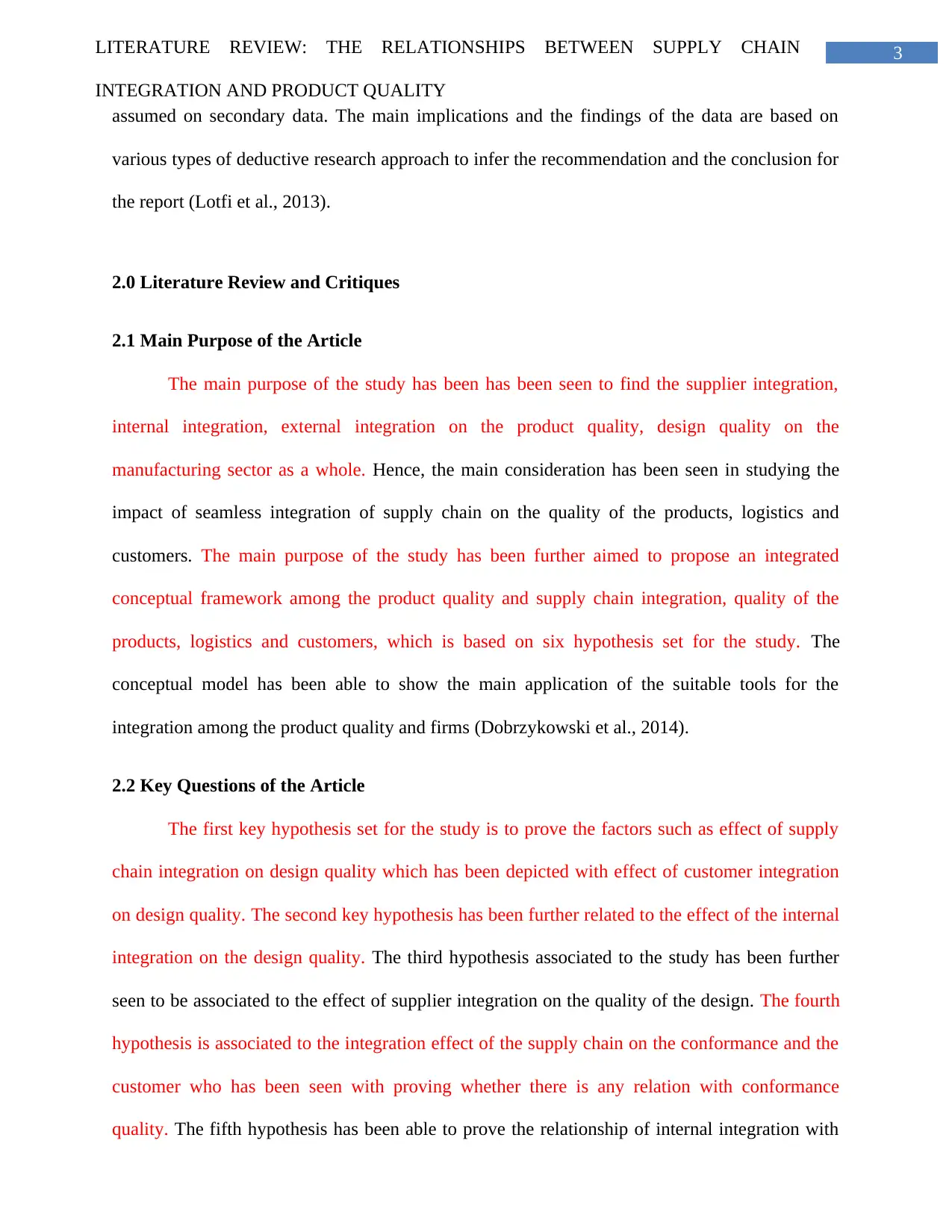
3LITERATURE REVIEW: THE RELATIONSHIPS BETWEEN SUPPLY CHAIN
INTEGRATION AND PRODUCT QUALITY
assumed on secondary data. The main implications and the findings of the data are based on
various types of deductive research approach to infer the recommendation and the conclusion for
the report (Lotfi et al., 2013).
2.0 Literature Review and Critiques
2.1 Main Purpose of the Article
The main purpose of the study has been has been seen to find the supplier integration,
internal integration, external integration on the product quality, design quality on the
manufacturing sector as a whole. Hence, the main consideration has been seen in studying the
impact of seamless integration of supply chain on the quality of the products, logistics and
customers. The main purpose of the study has been further aimed to propose an integrated
conceptual framework among the product quality and supply chain integration, quality of the
products, logistics and customers, which is based on six hypothesis set for the study. The
conceptual model has been able to show the main application of the suitable tools for the
integration among the product quality and firms (Dobrzykowski et al., 2014).
2.2 Key Questions of the Article
The first key hypothesis set for the study is to prove the factors such as effect of supply
chain integration on design quality which has been depicted with effect of customer integration
on design quality. The second key hypothesis has been further related to the effect of the internal
integration on the design quality. The third hypothesis associated to the study has been further
seen to be associated to the effect of supplier integration on the quality of the design. The fourth
hypothesis is associated to the integration effect of the supply chain on the conformance and the
customer who has been seen with proving whether there is any relation with conformance
quality. The fifth hypothesis has been able to prove the relationship of internal integration with
INTEGRATION AND PRODUCT QUALITY
assumed on secondary data. The main implications and the findings of the data are based on
various types of deductive research approach to infer the recommendation and the conclusion for
the report (Lotfi et al., 2013).
2.0 Literature Review and Critiques
2.1 Main Purpose of the Article
The main purpose of the study has been has been seen to find the supplier integration,
internal integration, external integration on the product quality, design quality on the
manufacturing sector as a whole. Hence, the main consideration has been seen in studying the
impact of seamless integration of supply chain on the quality of the products, logistics and
customers. The main purpose of the study has been further aimed to propose an integrated
conceptual framework among the product quality and supply chain integration, quality of the
products, logistics and customers, which is based on six hypothesis set for the study. The
conceptual model has been able to show the main application of the suitable tools for the
integration among the product quality and firms (Dobrzykowski et al., 2014).
2.2 Key Questions of the Article
The first key hypothesis set for the study is to prove the factors such as effect of supply
chain integration on design quality which has been depicted with effect of customer integration
on design quality. The second key hypothesis has been further related to the effect of the internal
integration on the design quality. The third hypothesis associated to the study has been further
seen to be associated to the effect of supplier integration on the quality of the design. The fourth
hypothesis is associated to the integration effect of the supply chain on the conformance and the
customer who has been seen with proving whether there is any relation with conformance
quality. The fifth hypothesis has been able to prove the relationship of internal integration with
Paraphrase This Document
Need a fresh take? Get an instant paraphrase of this document with our AI Paraphraser
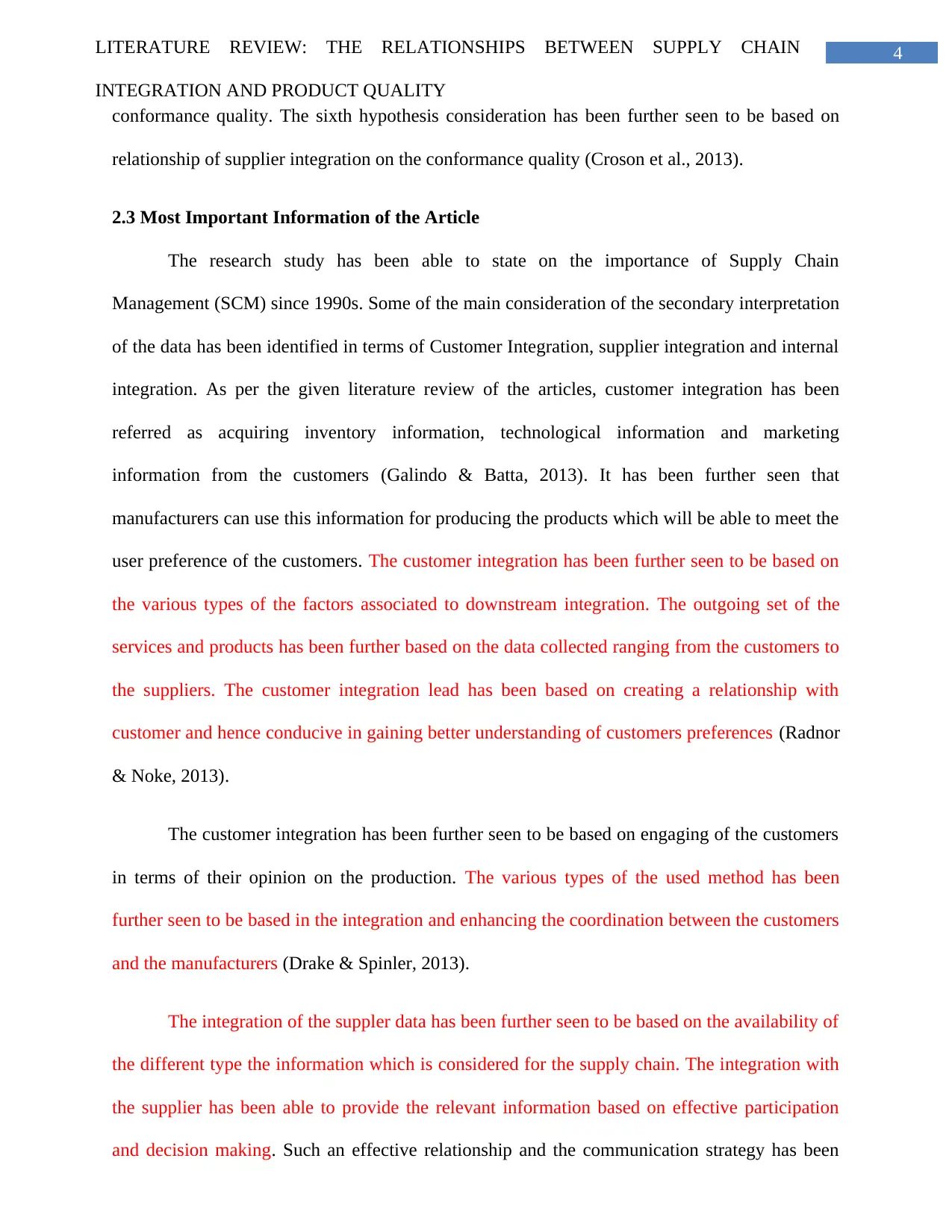
4LITERATURE REVIEW: THE RELATIONSHIPS BETWEEN SUPPLY CHAIN
INTEGRATION AND PRODUCT QUALITY
conformance quality. The sixth hypothesis consideration has been further seen to be based on
relationship of supplier integration on the conformance quality (Croson et al., 2013).
2.3 Most Important Information of the Article
The research study has been able to state on the importance of Supply Chain
Management (SCM) since 1990s. Some of the main consideration of the secondary interpretation
of the data has been identified in terms of Customer Integration, supplier integration and internal
integration. As per the given literature review of the articles, customer integration has been
referred as acquiring inventory information, technological information and marketing
information from the customers (Galindo & Batta, 2013). It has been further seen that
manufacturers can use this information for producing the products which will be able to meet the
user preference of the customers. The customer integration has been further seen to be based on
the various types of the factors associated to downstream integration. The outgoing set of the
services and products has been further based on the data collected ranging from the customers to
the suppliers. The customer integration lead has been based on creating a relationship with
customer and hence conducive in gaining better understanding of customers preferences (Radnor
& Noke, 2013).
The customer integration has been further seen to be based on engaging of the customers
in terms of their opinion on the production. The various types of the used method has been
further seen to be based in the integration and enhancing the coordination between the customers
and the manufacturers (Drake & Spinler, 2013).
The integration of the suppler data has been further seen to be based on the availability of
the different type the information which is considered for the supply chain. The integration with
the supplier has been able to provide the relevant information based on effective participation
and decision making. Such an effective relationship and the communication strategy has been
INTEGRATION AND PRODUCT QUALITY
conformance quality. The sixth hypothesis consideration has been further seen to be based on
relationship of supplier integration on the conformance quality (Croson et al., 2013).
2.3 Most Important Information of the Article
The research study has been able to state on the importance of Supply Chain
Management (SCM) since 1990s. Some of the main consideration of the secondary interpretation
of the data has been identified in terms of Customer Integration, supplier integration and internal
integration. As per the given literature review of the articles, customer integration has been
referred as acquiring inventory information, technological information and marketing
information from the customers (Galindo & Batta, 2013). It has been further seen that
manufacturers can use this information for producing the products which will be able to meet the
user preference of the customers. The customer integration has been further seen to be based on
the various types of the factors associated to downstream integration. The outgoing set of the
services and products has been further based on the data collected ranging from the customers to
the suppliers. The customer integration lead has been based on creating a relationship with
customer and hence conducive in gaining better understanding of customers preferences (Radnor
& Noke, 2013).
The customer integration has been further seen to be based on engaging of the customers
in terms of their opinion on the production. The various types of the used method has been
further seen to be based in the integration and enhancing the coordination between the customers
and the manufacturers (Drake & Spinler, 2013).
The integration of the suppler data has been further seen to be based on the availability of
the different type the information which is considered for the supply chain. The integration with
the supplier has been able to provide the relevant information based on effective participation
and decision making. Such an effective relationship and the communication strategy has been
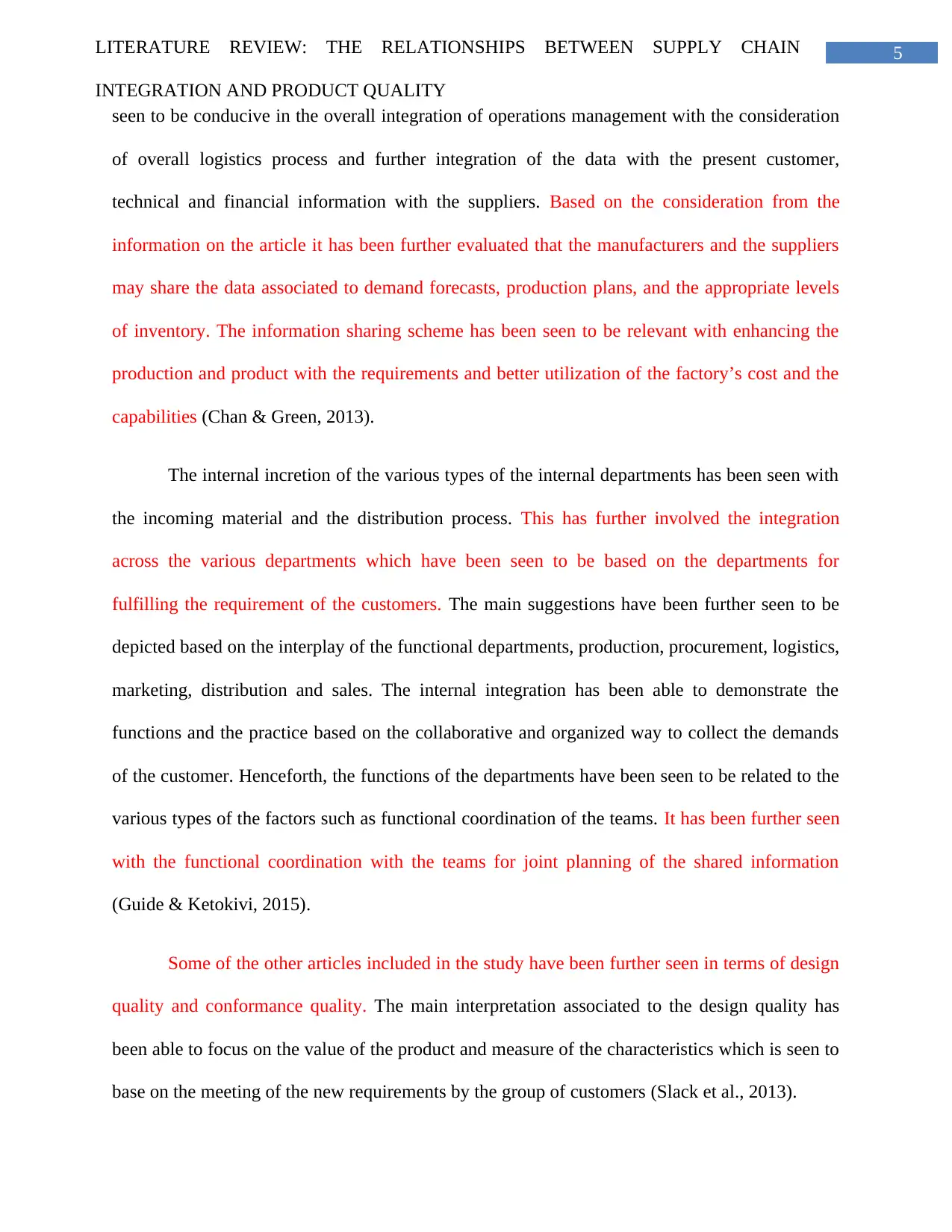
5LITERATURE REVIEW: THE RELATIONSHIPS BETWEEN SUPPLY CHAIN
INTEGRATION AND PRODUCT QUALITY
seen to be conducive in the overall integration of operations management with the consideration
of overall logistics process and further integration of the data with the present customer,
technical and financial information with the suppliers. Based on the consideration from the
information on the article it has been further evaluated that the manufacturers and the suppliers
may share the data associated to demand forecasts, production plans, and the appropriate levels
of inventory. The information sharing scheme has been seen to be relevant with enhancing the
production and product with the requirements and better utilization of the factory’s cost and the
capabilities (Chan & Green, 2013).
The internal incretion of the various types of the internal departments has been seen with
the incoming material and the distribution process. This has further involved the integration
across the various departments which have been seen to be based on the departments for
fulfilling the requirement of the customers. The main suggestions have been further seen to be
depicted based on the interplay of the functional departments, production, procurement, logistics,
marketing, distribution and sales. The internal integration has been able to demonstrate the
functions and the practice based on the collaborative and organized way to collect the demands
of the customer. Henceforth, the functions of the departments have been seen to be related to the
various types of the factors such as functional coordination of the teams. It has been further seen
with the functional coordination with the teams for joint planning of the shared information
(Guide & Ketokivi, 2015).
Some of the other articles included in the study have been further seen in terms of design
quality and conformance quality. The main interpretation associated to the design quality has
been able to focus on the value of the product and measure of the characteristics which is seen to
base on the meeting of the new requirements by the group of customers (Slack et al., 2013).
INTEGRATION AND PRODUCT QUALITY
seen to be conducive in the overall integration of operations management with the consideration
of overall logistics process and further integration of the data with the present customer,
technical and financial information with the suppliers. Based on the consideration from the
information on the article it has been further evaluated that the manufacturers and the suppliers
may share the data associated to demand forecasts, production plans, and the appropriate levels
of inventory. The information sharing scheme has been seen to be relevant with enhancing the
production and product with the requirements and better utilization of the factory’s cost and the
capabilities (Chan & Green, 2013).
The internal incretion of the various types of the internal departments has been seen with
the incoming material and the distribution process. This has further involved the integration
across the various departments which have been seen to be based on the departments for
fulfilling the requirement of the customers. The main suggestions have been further seen to be
depicted based on the interplay of the functional departments, production, procurement, logistics,
marketing, distribution and sales. The internal integration has been able to demonstrate the
functions and the practice based on the collaborative and organized way to collect the demands
of the customer. Henceforth, the functions of the departments have been seen to be related to the
various types of the factors such as functional coordination of the teams. It has been further seen
with the functional coordination with the teams for joint planning of the shared information
(Guide & Ketokivi, 2015).
Some of the other articles included in the study have been further seen in terms of design
quality and conformance quality. The main interpretation associated to the design quality has
been able to focus on the value of the product and measure of the characteristics which is seen to
base on the meeting of the new requirements by the group of customers (Slack et al., 2013).
⊘ This is a preview!⊘
Do you want full access?
Subscribe today to unlock all pages.

Trusted by 1+ million students worldwide
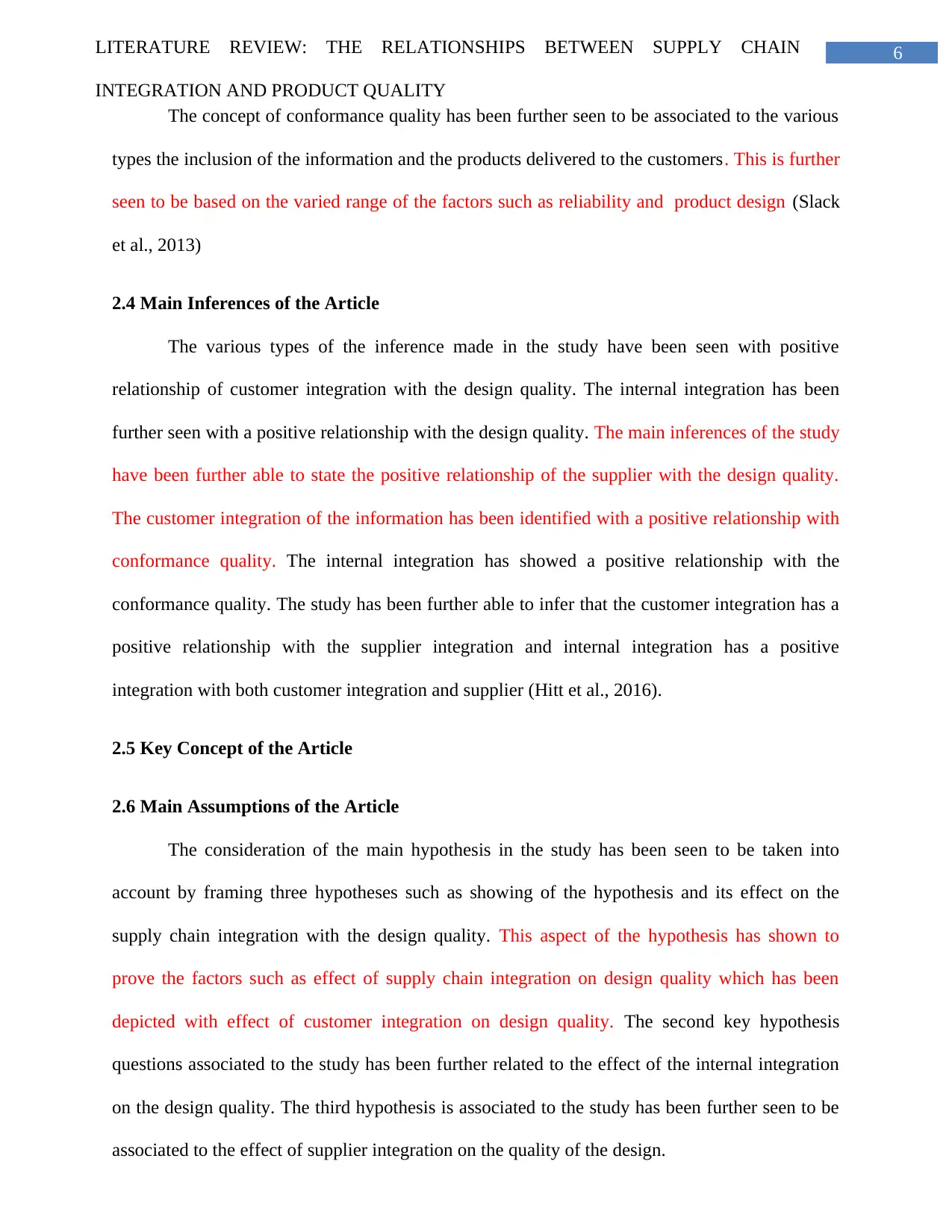
6LITERATURE REVIEW: THE RELATIONSHIPS BETWEEN SUPPLY CHAIN
INTEGRATION AND PRODUCT QUALITY
The concept of conformance quality has been further seen to be associated to the various
types the inclusion of the information and the products delivered to the customers. This is further
seen to be based on the varied range of the factors such as reliability and product design (Slack
et al., 2013)
2.4 Main Inferences of the Article
The various types of the inference made in the study have been seen with positive
relationship of customer integration with the design quality. The internal integration has been
further seen with a positive relationship with the design quality. The main inferences of the study
have been further able to state the positive relationship of the supplier with the design quality.
The customer integration of the information has been identified with a positive relationship with
conformance quality. The internal integration has showed a positive relationship with the
conformance quality. The study has been further able to infer that the customer integration has a
positive relationship with the supplier integration and internal integration has a positive
integration with both customer integration and supplier (Hitt et al., 2016).
2.5 Key Concept of the Article
2.6 Main Assumptions of the Article
The consideration of the main hypothesis in the study has been seen to be taken into
account by framing three hypotheses such as showing of the hypothesis and its effect on the
supply chain integration with the design quality. This aspect of the hypothesis has shown to
prove the factors such as effect of supply chain integration on design quality which has been
depicted with effect of customer integration on design quality. The second key hypothesis
questions associated to the study has been further related to the effect of the internal integration
on the design quality. The third hypothesis is associated to the study has been further seen to be
associated to the effect of supplier integration on the quality of the design.
INTEGRATION AND PRODUCT QUALITY
The concept of conformance quality has been further seen to be associated to the various
types the inclusion of the information and the products delivered to the customers. This is further
seen to be based on the varied range of the factors such as reliability and product design (Slack
et al., 2013)
2.4 Main Inferences of the Article
The various types of the inference made in the study have been seen with positive
relationship of customer integration with the design quality. The internal integration has been
further seen with a positive relationship with the design quality. The main inferences of the study
have been further able to state the positive relationship of the supplier with the design quality.
The customer integration of the information has been identified with a positive relationship with
conformance quality. The internal integration has showed a positive relationship with the
conformance quality. The study has been further able to infer that the customer integration has a
positive relationship with the supplier integration and internal integration has a positive
integration with both customer integration and supplier (Hitt et al., 2016).
2.5 Key Concept of the Article
2.6 Main Assumptions of the Article
The consideration of the main hypothesis in the study has been seen to be taken into
account by framing three hypotheses such as showing of the hypothesis and its effect on the
supply chain integration with the design quality. This aspect of the hypothesis has shown to
prove the factors such as effect of supply chain integration on design quality which has been
depicted with effect of customer integration on design quality. The second key hypothesis
questions associated to the study has been further related to the effect of the internal integration
on the design quality. The third hypothesis is associated to the study has been further seen to be
associated to the effect of supplier integration on the quality of the design.
Paraphrase This Document
Need a fresh take? Get an instant paraphrase of this document with our AI Paraphraser
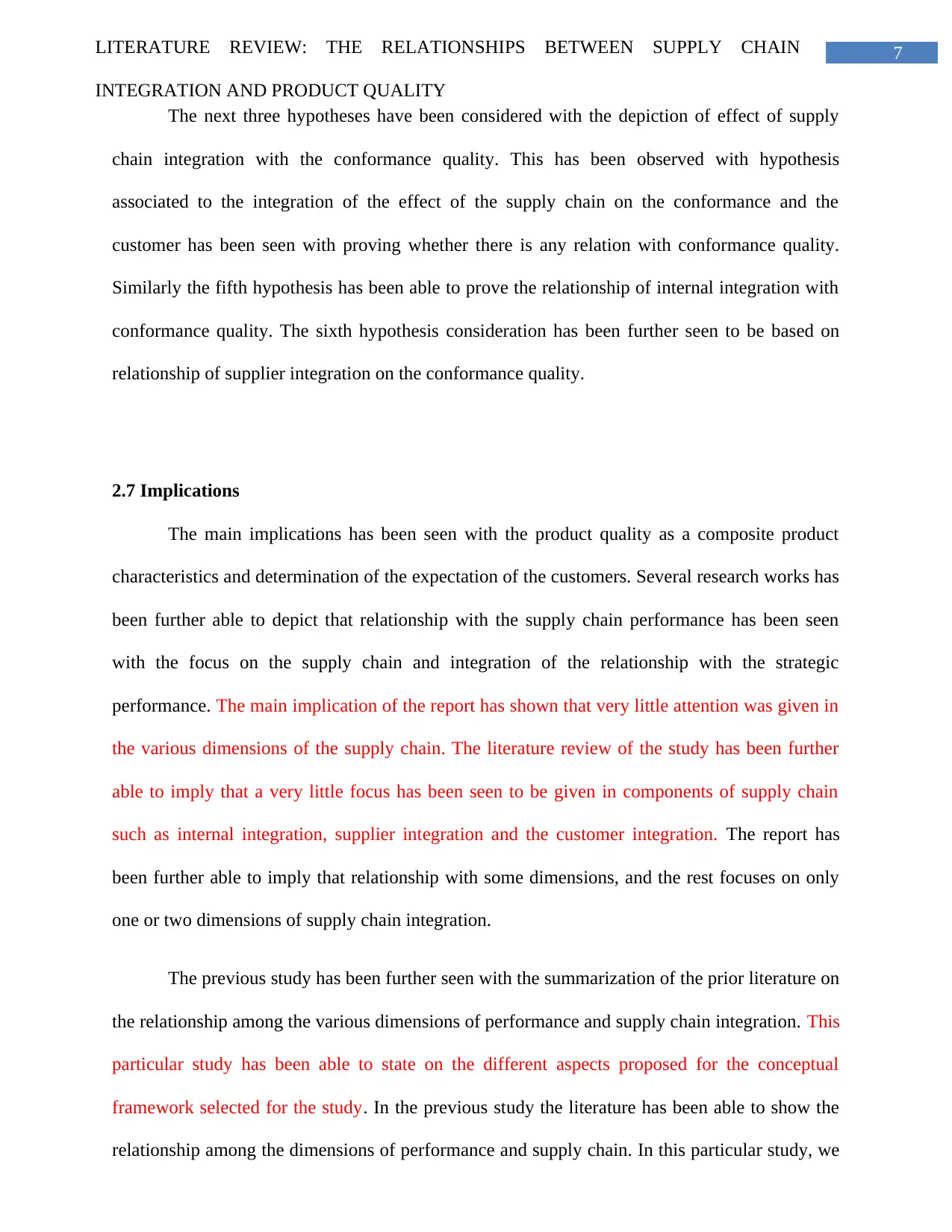
7LITERATURE REVIEW: THE RELATIONSHIPS BETWEEN SUPPLY CHAIN
INTEGRATION AND PRODUCT QUALITY
The next three hypotheses have been considered with the depiction of effect of supply
chain integration with the conformance quality. This has been observed with hypothesis
associated to the integration of the effect of the supply chain on the conformance and the
customer has been seen with proving whether there is any relation with conformance quality.
Similarly the fifth hypothesis has been able to prove the relationship of internal integration with
conformance quality. The sixth hypothesis consideration has been further seen to be based on
relationship of supplier integration on the conformance quality.
2.7 Implications
The main implications has been seen with the product quality as a composite product
characteristics and determination of the expectation of the customers. Several research works has
been further able to depict that relationship with the supply chain performance has been seen
with the focus on the supply chain and integration of the relationship with the strategic
performance. The main implication of the report has shown that very little attention was given in
the various dimensions of the supply chain. The literature review of the study has been further
able to imply that a very little focus has been seen to be given in components of supply chain
such as internal integration, supplier integration and the customer integration. The report has
been further able to imply that relationship with some dimensions, and the rest focuses on only
one or two dimensions of supply chain integration.
The previous study has been further seen with the summarization of the prior literature on
the relationship among the various dimensions of performance and supply chain integration. This
particular study has been able to state on the different aspects proposed for the conceptual
framework selected for the study. In the previous study the literature has been able to show the
relationship among the dimensions of performance and supply chain. In this particular study, we
INTEGRATION AND PRODUCT QUALITY
The next three hypotheses have been considered with the depiction of effect of supply
chain integration with the conformance quality. This has been observed with hypothesis
associated to the integration of the effect of the supply chain on the conformance and the
customer has been seen with proving whether there is any relation with conformance quality.
Similarly the fifth hypothesis has been able to prove the relationship of internal integration with
conformance quality. The sixth hypothesis consideration has been further seen to be based on
relationship of supplier integration on the conformance quality.
2.7 Implications
The main implications has been seen with the product quality as a composite product
characteristics and determination of the expectation of the customers. Several research works has
been further able to depict that relationship with the supply chain performance has been seen
with the focus on the supply chain and integration of the relationship with the strategic
performance. The main implication of the report has shown that very little attention was given in
the various dimensions of the supply chain. The literature review of the study has been further
able to imply that a very little focus has been seen to be given in components of supply chain
such as internal integration, supplier integration and the customer integration. The report has
been further able to imply that relationship with some dimensions, and the rest focuses on only
one or two dimensions of supply chain integration.
The previous study has been further seen with the summarization of the prior literature on
the relationship among the various dimensions of performance and supply chain integration. This
particular study has been able to state on the different aspects proposed for the conceptual
framework selected for the study. In the previous study the literature has been able to show the
relationship among the dimensions of performance and supply chain. In this particular study, we
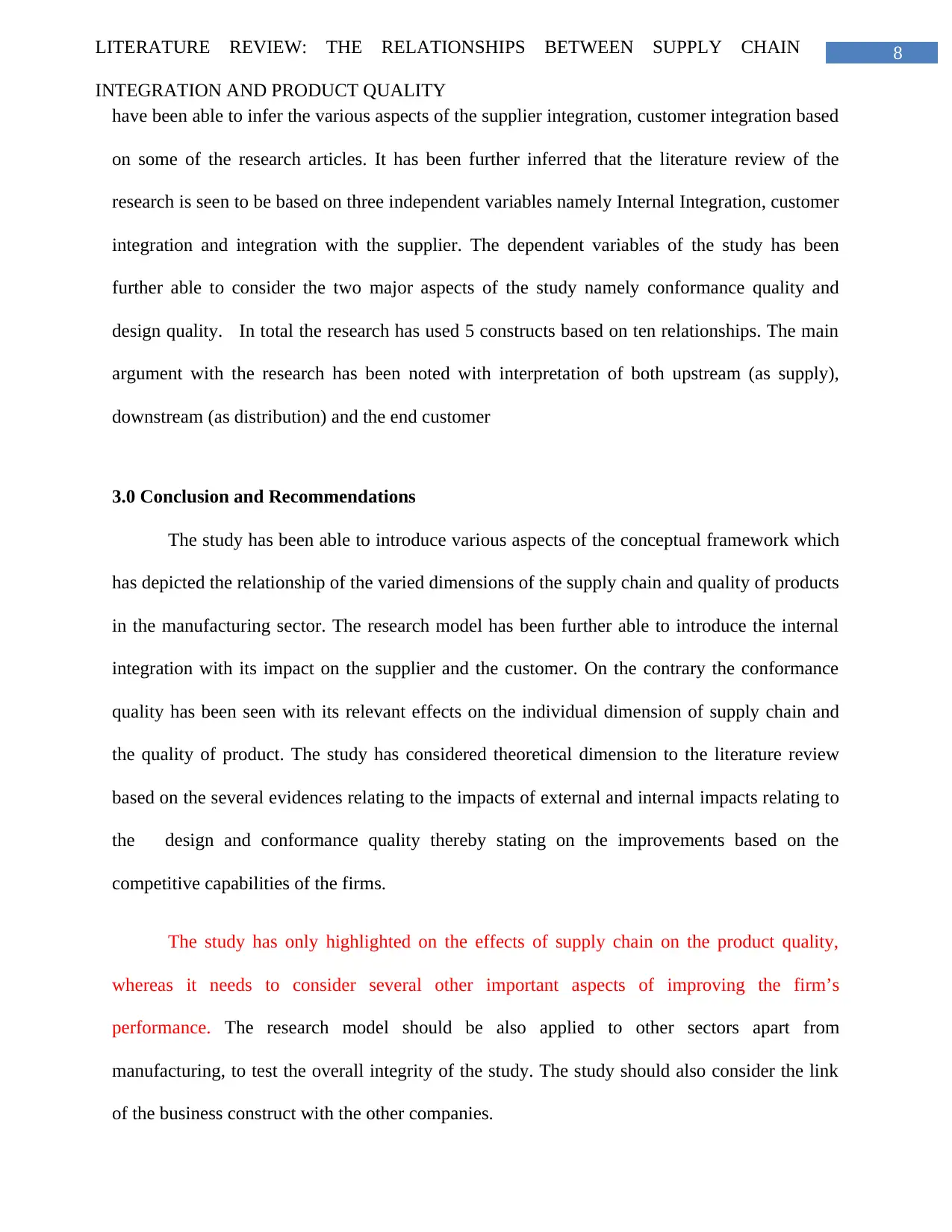
8LITERATURE REVIEW: THE RELATIONSHIPS BETWEEN SUPPLY CHAIN
INTEGRATION AND PRODUCT QUALITY
have been able to infer the various aspects of the supplier integration, customer integration based
on some of the research articles. It has been further inferred that the literature review of the
research is seen to be based on three independent variables namely Internal Integration, customer
integration and integration with the supplier. The dependent variables of the study has been
further able to consider the two major aspects of the study namely conformance quality and
design quality. In total the research has used 5 constructs based on ten relationships. The main
argument with the research has been noted with interpretation of both upstream (as supply),
downstream (as distribution) and the end customer
3.0 Conclusion and Recommendations
The study has been able to introduce various aspects of the conceptual framework which
has depicted the relationship of the varied dimensions of the supply chain and quality of products
in the manufacturing sector. The research model has been further able to introduce the internal
integration with its impact on the supplier and the customer. On the contrary the conformance
quality has been seen with its relevant effects on the individual dimension of supply chain and
the quality of product. The study has considered theoretical dimension to the literature review
based on the several evidences relating to the impacts of external and internal impacts relating to
the design and conformance quality thereby stating on the improvements based on the
competitive capabilities of the firms.
The study has only highlighted on the effects of supply chain on the product quality,
whereas it needs to consider several other important aspects of improving the firm’s
performance. The research model should be also applied to other sectors apart from
manufacturing, to test the overall integrity of the study. The study should also consider the link
of the business construct with the other companies.
INTEGRATION AND PRODUCT QUALITY
have been able to infer the various aspects of the supplier integration, customer integration based
on some of the research articles. It has been further inferred that the literature review of the
research is seen to be based on three independent variables namely Internal Integration, customer
integration and integration with the supplier. The dependent variables of the study has been
further able to consider the two major aspects of the study namely conformance quality and
design quality. In total the research has used 5 constructs based on ten relationships. The main
argument with the research has been noted with interpretation of both upstream (as supply),
downstream (as distribution) and the end customer
3.0 Conclusion and Recommendations
The study has been able to introduce various aspects of the conceptual framework which
has depicted the relationship of the varied dimensions of the supply chain and quality of products
in the manufacturing sector. The research model has been further able to introduce the internal
integration with its impact on the supplier and the customer. On the contrary the conformance
quality has been seen with its relevant effects on the individual dimension of supply chain and
the quality of product. The study has considered theoretical dimension to the literature review
based on the several evidences relating to the impacts of external and internal impacts relating to
the design and conformance quality thereby stating on the improvements based on the
competitive capabilities of the firms.
The study has only highlighted on the effects of supply chain on the product quality,
whereas it needs to consider several other important aspects of improving the firm’s
performance. The research model should be also applied to other sectors apart from
manufacturing, to test the overall integrity of the study. The study should also consider the link
of the business construct with the other companies.
⊘ This is a preview!⊘
Do you want full access?
Subscribe today to unlock all pages.

Trusted by 1+ million students worldwide
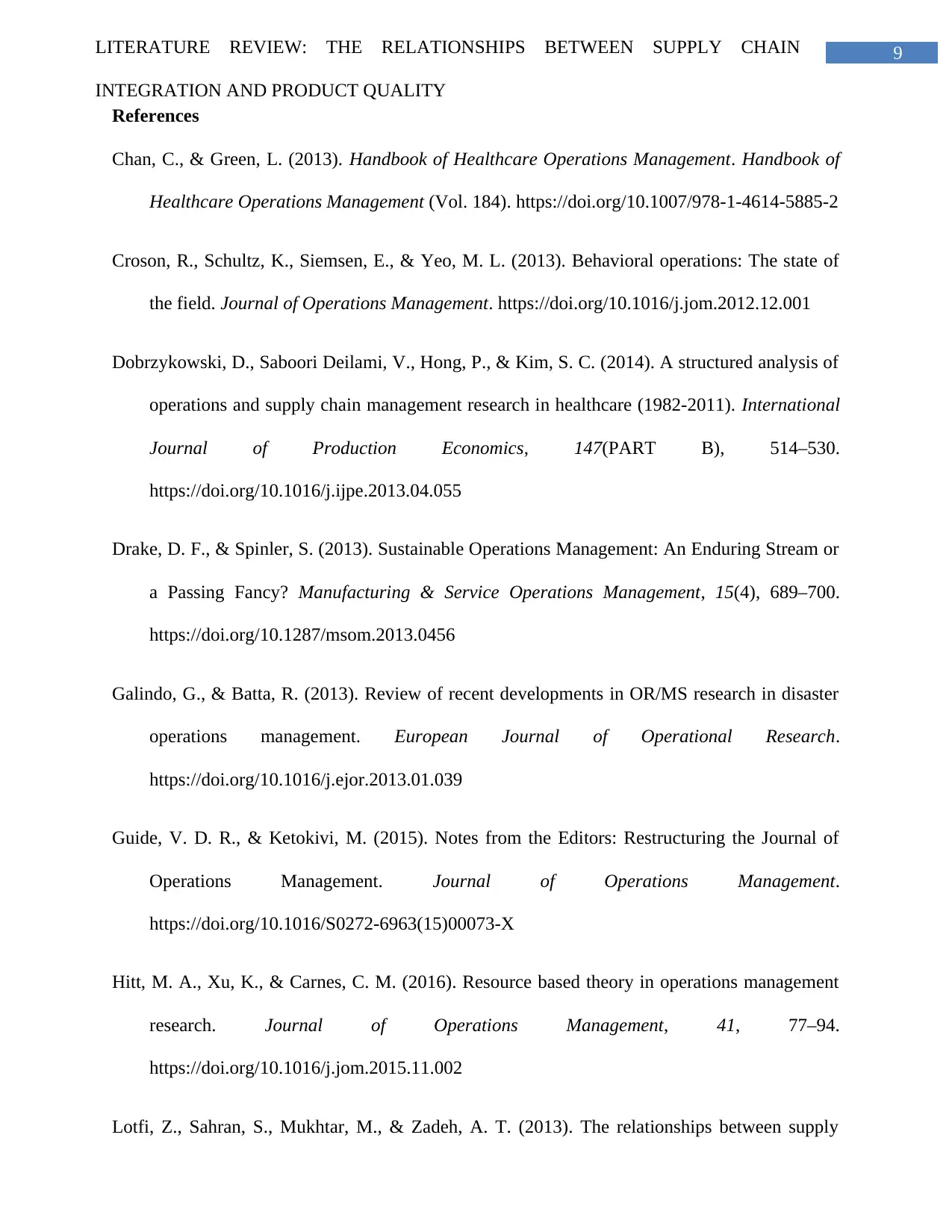
9LITERATURE REVIEW: THE RELATIONSHIPS BETWEEN SUPPLY CHAIN
INTEGRATION AND PRODUCT QUALITY
References
Chan, C., & Green, L. (2013). Handbook of Healthcare Operations Management. Handbook of
Healthcare Operations Management (Vol. 184). https://doi.org/10.1007/978-1-4614-5885-2
Croson, R., Schultz, K., Siemsen, E., & Yeo, M. L. (2013). Behavioral operations: The state of
the field. Journal of Operations Management. https://doi.org/10.1016/j.jom.2012.12.001
Dobrzykowski, D., Saboori Deilami, V., Hong, P., & Kim, S. C. (2014). A structured analysis of
operations and supply chain management research in healthcare (1982-2011). International
Journal of Production Economics, 147(PART B), 514–530.
https://doi.org/10.1016/j.ijpe.2013.04.055
Drake, D. F., & Spinler, S. (2013). Sustainable Operations Management: An Enduring Stream or
a Passing Fancy? Manufacturing & Service Operations Management, 15(4), 689–700.
https://doi.org/10.1287/msom.2013.0456
Galindo, G., & Batta, R. (2013). Review of recent developments in OR/MS research in disaster
operations management. European Journal of Operational Research.
https://doi.org/10.1016/j.ejor.2013.01.039
Guide, V. D. R., & Ketokivi, M. (2015). Notes from the Editors: Restructuring the Journal of
Operations Management. Journal of Operations Management.
https://doi.org/10.1016/S0272-6963(15)00073-X
Hitt, M. A., Xu, K., & Carnes, C. M. (2016). Resource based theory in operations management
research. Journal of Operations Management, 41, 77–94.
https://doi.org/10.1016/j.jom.2015.11.002
Lotfi, Z., Sahran, S., Mukhtar, M., & Zadeh, A. T. (2013). The relationships between supply
INTEGRATION AND PRODUCT QUALITY
References
Chan, C., & Green, L. (2013). Handbook of Healthcare Operations Management. Handbook of
Healthcare Operations Management (Vol. 184). https://doi.org/10.1007/978-1-4614-5885-2
Croson, R., Schultz, K., Siemsen, E., & Yeo, M. L. (2013). Behavioral operations: The state of
the field. Journal of Operations Management. https://doi.org/10.1016/j.jom.2012.12.001
Dobrzykowski, D., Saboori Deilami, V., Hong, P., & Kim, S. C. (2014). A structured analysis of
operations and supply chain management research in healthcare (1982-2011). International
Journal of Production Economics, 147(PART B), 514–530.
https://doi.org/10.1016/j.ijpe.2013.04.055
Drake, D. F., & Spinler, S. (2013). Sustainable Operations Management: An Enduring Stream or
a Passing Fancy? Manufacturing & Service Operations Management, 15(4), 689–700.
https://doi.org/10.1287/msom.2013.0456
Galindo, G., & Batta, R. (2013). Review of recent developments in OR/MS research in disaster
operations management. European Journal of Operational Research.
https://doi.org/10.1016/j.ejor.2013.01.039
Guide, V. D. R., & Ketokivi, M. (2015). Notes from the Editors: Restructuring the Journal of
Operations Management. Journal of Operations Management.
https://doi.org/10.1016/S0272-6963(15)00073-X
Hitt, M. A., Xu, K., & Carnes, C. M. (2016). Resource based theory in operations management
research. Journal of Operations Management, 41, 77–94.
https://doi.org/10.1016/j.jom.2015.11.002
Lotfi, Z., Sahran, S., Mukhtar, M., & Zadeh, A. T. (2013). The relationships between supply
Paraphrase This Document
Need a fresh take? Get an instant paraphrase of this document with our AI Paraphraser
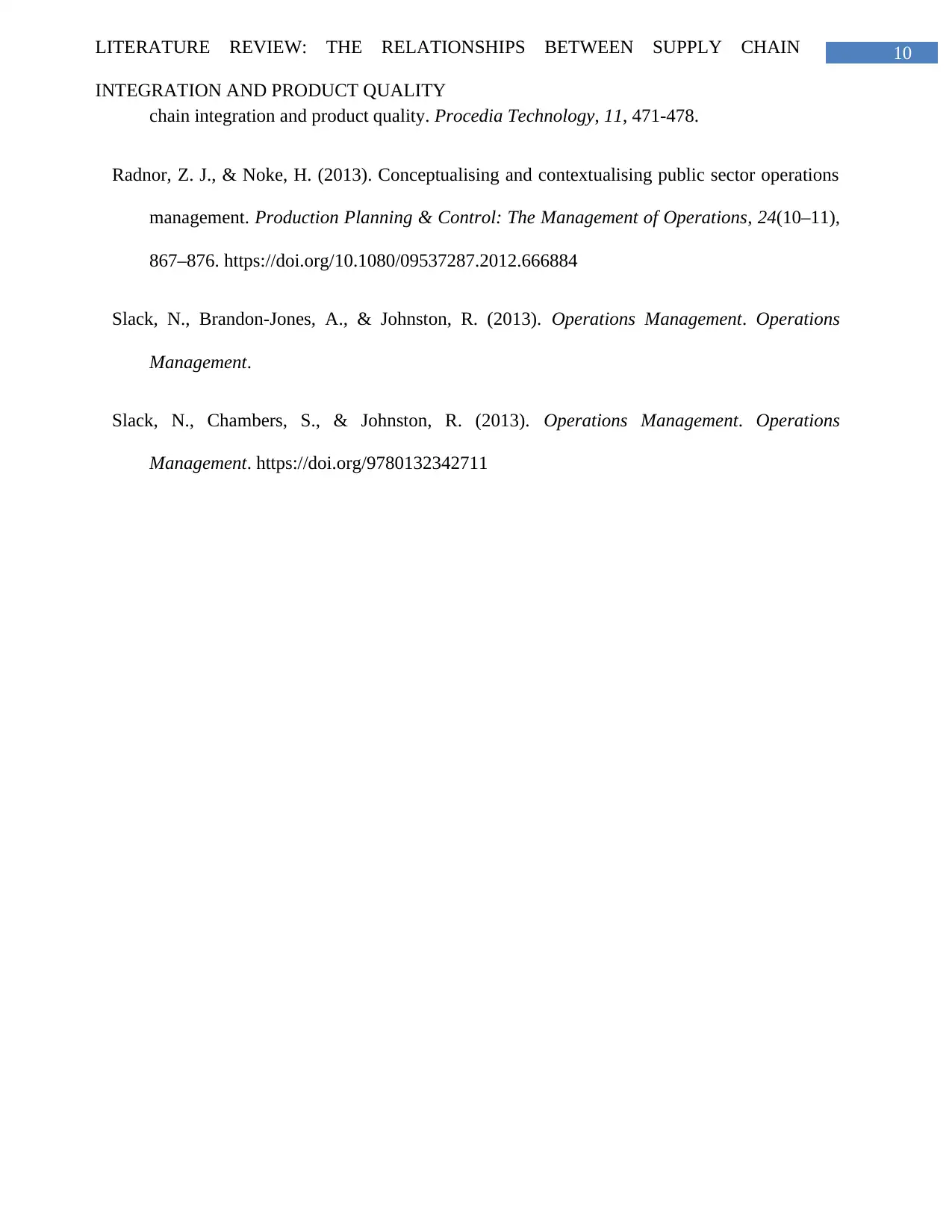
10LITERATURE REVIEW: THE RELATIONSHIPS BETWEEN SUPPLY CHAIN
INTEGRATION AND PRODUCT QUALITY
chain integration and product quality. Procedia Technology, 11, 471-478.
Radnor, Z. J., & Noke, H. (2013). Conceptualising and contextualising public sector operations
management. Production Planning & Control: The Management of Operations, 24(10–11),
867–876. https://doi.org/10.1080/09537287.2012.666884
Slack, N., Brandon-Jones, A., & Johnston, R. (2013). Operations Management. Operations
Management.
Slack, N., Chambers, S., & Johnston, R. (2013). Operations Management. Operations
Management. https://doi.org/9780132342711
INTEGRATION AND PRODUCT QUALITY
chain integration and product quality. Procedia Technology, 11, 471-478.
Radnor, Z. J., & Noke, H. (2013). Conceptualising and contextualising public sector operations
management. Production Planning & Control: The Management of Operations, 24(10–11),
867–876. https://doi.org/10.1080/09537287.2012.666884
Slack, N., Brandon-Jones, A., & Johnston, R. (2013). Operations Management. Operations
Management.
Slack, N., Chambers, S., & Johnston, R. (2013). Operations Management. Operations
Management. https://doi.org/9780132342711
1 out of 11
Related Documents
Your All-in-One AI-Powered Toolkit for Academic Success.
+13062052269
info@desklib.com
Available 24*7 on WhatsApp / Email
![[object Object]](/_next/static/media/star-bottom.7253800d.svg)
Unlock your academic potential
Copyright © 2020–2025 A2Z Services. All Rights Reserved. Developed and managed by ZUCOL.





